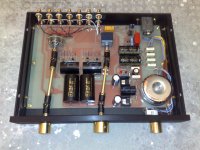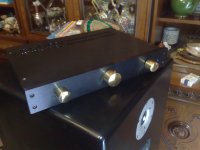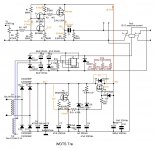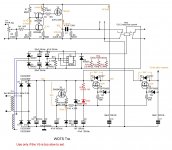Okay, so there's Mozart or Beethoven conducting an orchestra at the front of the band shell. Are they listening to a nice laid back "warm and fuzzy representation".He liked WOTS, he told me.
I suspect if they were they would have been struggling to control their gag reflexes!
wha happened to the regurgitation emoji??
sheesh! I'm liking this new format less and less 😡
Beethoven could not hear anything clearly when he was old and conducting his No.9.
But he would enjoy his No.9 and conducting very much.
But he would enjoy his No.9 and conducting very much.
yes, it was all in his head...poor analogy, but only for him.Beethoven could not hear anything clearly when he was old and conducting his No.9.
You think "accurate reproducing" is a must, go for it. But a real music can not be accurately reproduced by any "100% accurate device" if there is any. You can only wish that recorded music signal from a CD or streaming provider can be reproduced until the output of amplifiers.
No, I know, as we all do, that nothing is perfect. But striving for it is the only way to get as close as possible.
I'm a renovation contractor. When I'm framing a structure I strive to be as accurate with my measurements as I can possibly be during construction because that way the small inaccuracy I began with stays that way. If I'm not the accumulated tiny inaccuracies result in a large deviation.
With an amp, it doesn't matter how inaccurate the source is. Coloring it is like putting too many different spices in a dish you're cooking. It just ends up an unidentifiable mishmash. The job of the amp is a faithful reproduction of the recording. Otherwise you'll have the odd recording that's been helped a little but the rest are ruined.
I'm a renovation contractor. When I'm framing a structure I strive to be as accurate with my measurements as I can possibly be during construction because that way the small inaccuracy I began with stays that way. If I'm not the accumulated tiny inaccuracies result in a large deviation.
With an amp, it doesn't matter how inaccurate the source is. Coloring it is like putting too many different spices in a dish you're cooking. It just ends up an unidentifiable mishmash. The job of the amp is a faithful reproduction of the recording. Otherwise you'll have the odd recording that's been helped a little but the rest are ruined.
Last edited:
Fellows, it's really amazing to follow your speech. I could learn a lot of new concepts.
I'm wondering how many of you listened to a WOTS.
I'm wondering how many of you listened to a WOTS.
Well, Hello,
I am new in this ... discussion so, please allow me to add an opinion and a request:
While, as an engineer I totally get the idea and principle of trying to make a totally transparent and neutral machine to reproduce music 'as recorded', I've also experienced the totally frustrating outcome of too many "perfect" (and outragiously expensive and complicated) such wonder machines.
As a music lover, I still find my self looking for some excitement and pleasure (and missing it in too many cases) while listening to my music collection which is so diverse and not perfectly recorded in most cases.
So, listening to the real recorded music through an audio chain which mainly succedes to reveal the real flaws of my recordings does not give me what I want: it might give me information but it kills the communication and the pleasure of listening to music.
Don't get me wrong: the quest for accuracy must be part of the total quest for music reproduction but it s not enough in its self. Not by a long far.
Now, my request: I would like to try and build (and listen to) the WOTS Tre.
Could you please share the schematic and possibly some guidelines for the realisation of it?
Thank you,
Stavros
I am new in this ... discussion so, please allow me to add an opinion and a request:
While, as an engineer I totally get the idea and principle of trying to make a totally transparent and neutral machine to reproduce music 'as recorded', I've also experienced the totally frustrating outcome of too many "perfect" (and outragiously expensive and complicated) such wonder machines.
As a music lover, I still find my self looking for some excitement and pleasure (and missing it in too many cases) while listening to my music collection which is so diverse and not perfectly recorded in most cases.
So, listening to the real recorded music through an audio chain which mainly succedes to reveal the real flaws of my recordings does not give me what I want: it might give me information but it kills the communication and the pleasure of listening to music.
Don't get me wrong: the quest for accuracy must be part of the total quest for music reproduction but it s not enough in its self. Not by a long far.
Now, my request: I would like to try and build (and listen to) the WOTS Tre.
Could you please share the schematic and possibly some guidelines for the realisation of it?
Thank you,
Stavros
Hello,Well, Hello,
I am new in this ... discussion so, please allow me to add an opinion and a request:
While, as an engineer I totally get the idea and principle of trying to make a totally transparent and neutral machine to reproduce music 'as recorded', I've also experienced the totally frustrating outcome of too many "perfect" (and outragiously expensive and complicated) such wonder machines.
As a music lover, I still find my self looking for some excitement and pleasure (and missing it in too many cases) while listening to my music collection which is so diverse and not perfectly recorded in most cases.
So, listening to the real recorded music through an audio chain which mainly succedes to reveal the real flaws of my recordings does not give me what I want: it might give me information but it kills the communication and the pleasure of listening to music.
Don't get me wrong: the quest for accuracy must be part of the total quest for music reproduction but it s not enough in its self. Not by a long far.
Now, my request: I would like to try and build (and listen to) the WOTS Tre.
Could you please share the schematic and possibly some guidelines for the realisation of it?
Thank you,
Stavros
I am pleased to note that we have exactly the same intentions in terms of listening to music. So, since we agree, I stop the discussion here. You explained the concept far better than I did.
First of all, I must say I do not like any kind of loop feedback, so the projects I like (mine or modified by me) are all zero feedback. Some are disturbed by this feature, some like it.
Just to let you know. Let's go on.
Before the WOTS projects, I tried the Engineer's approach and I must say it was not completely satisfying. The topology was Aikido's one. Not complicated at all, but expensive. I think everybody can agree with me if I say this is one of the most linear schematics of a preamplifier without any loop feedback.
I like Aikido a lot, I have two of them, the first made before the WOTS LeGrand, and the second, made some weeks ago, will be used the front end of a power amplifier. This is perhaps the best solution to use as a front end for a main amplifier, the so-called wire-with-gain.
So, since I was not satisfied with the first Aikido, as a preamplifier, I designed the WOTS LeGrand in 2003. It was completely satisfying. Not only to me but for some other friends who, once built the expensive Aikido, didn't like it.
Here are the schematic and 2 pictures of the WOTS Tre in a tiny cabinet. The build, at that time, 2008, had only one power supply to feed both channels. Should I build it again nowadays, I probably would choose a dual mono configuration.
I designed the Tre for a friend of mine who was in love with the LeGrand version but didn't like to work with tubes. We spent a whole day choosing the resistors on the cascode (R2, R7) until we got the same sound as the LeGrand version. The Cout we used was an MKP aluminum foil AudinCap.
The bad: the semiconductors used were obsolete even in 2008, nowadays you can find them only on eBay. For buying these semiconductors I would trust eBay. Or you can try newer components, just keep in mind the features on the datasheet of BF244-B (A and C versions are not suitable) and select a T2 mosfet with a very low input capacitance. I tried mosfets also on cascode but I didn't like this solution, JFETS are a lot better.
Trimming: R1 or R6 must be chosen to have 1/2 Vb (30V +/-10%) at the source of T2.
That's all for now. Let me know if you want to go on in a PM, I have the PCB Layout and the schematic both in CAD version and some suggestions. I do not want to bother here some susceptible fella.
Attachments
can a BF245B be used?
what would be the max Vpp output with decent distortion?
Would 20VPP be possible?
what would be the max Vpp output with decent distortion?
Would 20VPP be possible?
The BF245 is not perfectly the same but it seems you can use it without changing the Tre's sound, provided it is the BF245-B version (the pinout could be different).can a BF245B be used?
what would be the max Vpp output with decent distortion?
Would 20VPP be possible?
I didn't measure the maximum possible output voltage. I think it will be possible 15Vpp. It is not designed to drive a buffer, its gain is something more than 20dB, if you increase it you will lose the musicality. But you can try.
I'm designing about driving a buffer, I'm using Aikido's schematic with 12AX7 followed by a 12AU7 with a Vb of 300V; I'm sure it will allow a clear 110Vpp output voltage with a gain of something more than 30dB. So the output Vpp is a little more than Vb/3. For the same reason, the WOTS Tre should sport a 22Vpp output.
Hi,Hello,
I am pleased to note that we have exactly the same intentions in terms of listening to music. So, since we agree, I stop the discussion here. You explained the concept far better than I did.
First of all, I must say I do not like any kind of loop feedback, so the projects I like (mine or modified by me) are all zero feedback. Some are disturbed by this feature, some like it.
Just to let you know. Let's go on.
Before the WOTS projects, I tried the Engineer's approach and I must say it was not completely satisfying. The topology was Aikido's one. Not complicated at all, but expensive. I think everybody can agree with me if I say this is one of the most linear schematics of a preamplifier without any loop feedback.
I like Aikido a lot, I have two of them, the first made before the WOTS LeGrand, and the second, made some weeks ago, will be used the front end of a power amplifier. This is perhaps the best solution to use as a front end for a main amplifier, the so-called wire-with-gain.
So, since I was not satisfied with the first Aikido, as a preamplifier, I designed the WOTS LeGrand in 2003. It was completely satisfying. Not only to me but for some other friends who, once built the expensive Aikido, didn't like it.
Here are the schematic and 2 pictures of the WOTS Tre in a tiny cabinet. The build, at that time, 2008, had only one power supply to feed both channels. Should I build it again nowadays, I probably would choose a dual mono configuration.
I designed the Tre for a friend of mine who was in love with the LeGrand version but didn't like to work with tubes. We spent a whole day choosing the resistors on the cascode (R2, R7) until we got the same sound as the LeGrand version. The Cout we used was an MKP aluminum foil AudinCap.
The bad: the semiconductors used were obsolete even in 2008, nowadays you can find them only on eBay. For buying these semiconductors I would trust eBay. Or you can try newer components, just keep in mind the features on the datasheet of BF244-B (A and C versions are not suitable) and select a T2 mosfet with a very low input capacitance. I tried mosfets also on cascode but I didn't like this solution, JFETS are a lot better.
Trimming: R1 or R6 must be chosen to have 1/2 Vb (30V +/-10%) at the source of T2.
That's all for now. Let me know if you want to go on in a PM, I have the PCB Layout and the schematic both in CAD version and some suggestions. I do not want to bother here some susceptible fella.
Thank you for your kind quick response.
Yes, I am interested in trying this. It sounds interesting and exciting. I was experimenting with passive these days, initially for my Desk setup and then for my main system (looking to get rid of my NuVista Pre🙂). Not a very exclusive setup I am afraid: YBA Premiere Driving a pair of Dynaudios...
I am not so sure about the time I will be able to finish this, but I want to try it
Thanks again
Perfect I will try it. 15vpp is plenty for my high sensitivity speakers.
For the output mosfet, would an irfp610 have too much gate capacitance?
For the output mosfet, would an irfp610 have too much gate capacitance?
I read the datasheet of the IRFP610: the Cinput is 120pF, not bad. But, actually, you do not need a power transistor as a follower. Very important is to have the lowest possible Cinput. Remember: you are following a cascode, which has a very good band, but a very high output impedance. I wouldn't change anything, using components very different from the original ones.Perfect I will try it. 15vpp is plenty for my high sensitivity speakers.
For the output mosfet, would an irfp610 have too much gate capacitance?
I forgot to mention, you have to select the JFETS in order to have Vb/4 at the common point Dlow/Shigh. They cost$5 x 10 pieces on eBay, so it is not a problem.
I must apologize, the Tre schematic had some errors in the Power Supply section because I copied the Le Grand one. The schematic here enclosed is a better one. Being a Class-A design, a Dual Power Supply is not as important as in Class-B designs. A double regulator can be used as well.
Attachments
Me too.In my neck of the woods WOT means "With output transformer" so I was expecting to see a thread about that.
I am assisting another member in the building of the WOTS Tre. He bought a bunch of BF244B from China but they were fake BJTs. So he tried the 2SK170BL, but this is not suitable. Then he found some BF245B and these seem to be very close to what is needed. The datasheet of the BF256B shows more or less the same parameters of BF244B, so it seems this one could replace the BF244B.
Yes exactly the bf256b seems similar to bf244b and available at reichelt.de and tme.eu if it works fine it would be really a solution for all of us wanting to build wots tre!
 Another preamp that should give warmth to the sound should be ths but never tested. Credit to Doug Shelf
Another preamp that should give warmth to the sound should be ths but never tested. Credit to Doug Shelf
I don't know where you live, the BF256B is available also on US eBay, but you have to pick the right seller. They are not available on Mouser and Digikey.
D.Self is one of the best audio experts, I studied on D.Self's "Audio Power Amplifier Design Handbook, 6th Ed" when I worked on a Dartzeel NHB-108 clone. Take a look here: https://www.diyaudio.com/community/...matic-build-this.134362/page-105#post-6819080 . The schematic is a little tricky, if you are interested, I documented the building step by step with pictures and have an easier-to-read schematic. A folder I can send to anybody interested in building that monster.
About the schematic of D.Self you posted: I really like D.Self, but in this case, I would add a buffer to the BD139.
D.Self is one of the best audio experts, I studied on D.Self's "Audio Power Amplifier Design Handbook, 6th Ed" when I worked on a Dartzeel NHB-108 clone. Take a look here: https://www.diyaudio.com/community/...matic-build-this.134362/page-105#post-6819080 . The schematic is a little tricky, if you are interested, I documented the building step by step with pictures and have an easier-to-read schematic. A folder I can send to anybody interested in building that monster.
About the schematic of D.Self you posted: I really like D.Self, but in this case, I would add a buffer to the BD139.
Grazie per il link sto leggendo sembra un ottimo amplificatore bravo ottimo lavoro.
Sono italiano e vivo in Germania per questo reichelt.de
Sono italiano e vivo in Germania per questo reichelt.de
- Home
- Source & Line
- Analog Line Level
- Warmth Of The Sound - WOTS



